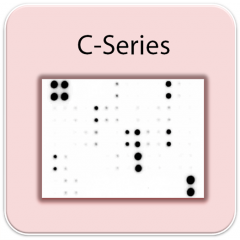Peroxisome proliferator-activated receptor alpha (PPAR-alpha also known as NR1C1) regulates a myriad of biological processes. It is a key modulator of lipid metabolism.

Vergori, L. et al. have shown in murine models how PPAR-alpha regulates endothelial progenitor cell maturation and myeloid lineage differentiation via a NADPH oxidase-dependent mechanism. (1) All the data described in this publication suggest that PPAR-alpha, in murine models, is a critical regulator of recruitment, homing and maturation of Bone Marrow-derived progenitor cells.
This conclusion was made (in part) possible with the analysis of secretome markers by using C-Series profiling arrays for the analysis of bone marrow-derived cells in PPAR-alpha wild-type vs. KO mice.
RayBio® Membrane-Based Antibody Arrays (C-Series) are tools for screening and comparing expression levels of many cytokines between samples. C-series Arrays are available as ready-to-use kits or lab services. To ensure top quality in the data obtained, Raybiotech’s service providers successfully complete training and certification programs to receive the “RayBiotech Certified Array Service Providers” yellow award.
In Europe, tebu-bio laboratories (France) were among the first laboratories in the world to be certified by Raybiotech in 2012.
tebu-bio’s services also cover Quansys BioSciences and FullMoon BioSystems technologies for outsourcing protein profiling and quantification.
Interested in studying the secretome biomarkers relevant in your model for Cardiovascular diseases?
Leave your comment or contact us!
Source:
(1) Vergori L. et al. “PPARa regulates endothelial progenitor cell maturation and myeloid lineage differentiation through a NADPH oxidase-dependent mechanism in mice” (2015) Stem Cells – 33 (4) :1292-303. DOI: 10.1002/stem.1924.



